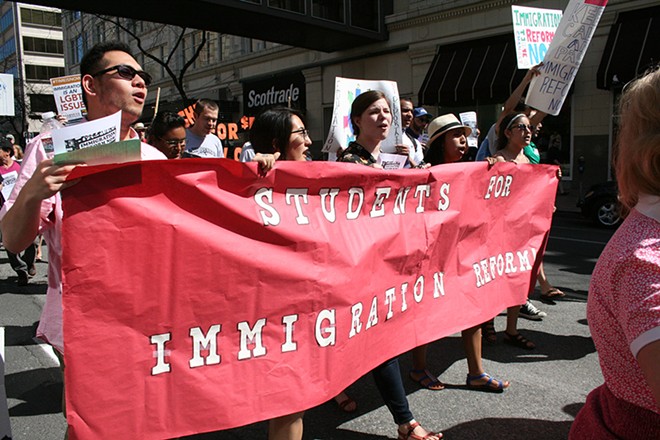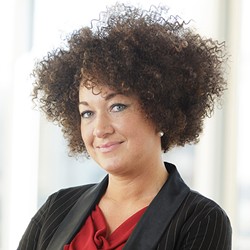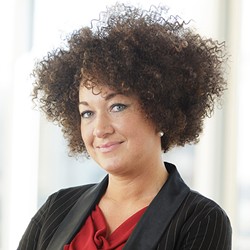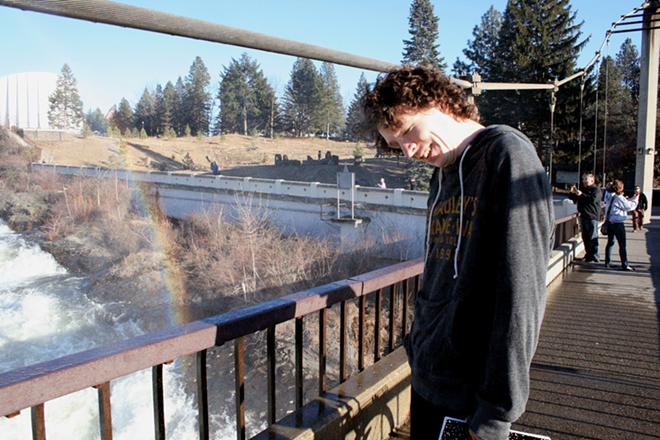Wednesday, May 7, 2014
Spring dresses or police barricades? Maypole dance or march? In school, May Day was all about making some type of paper cone receptacle for flowers to be anonymously left on neighbor’s doorsteps. There was a schoolyard-appropriate dance involving a pole. As students grow out of seasonal craft projects in their curriculum, the day fades back into obscurity.
Many countries celebrate May 1 as a public holiday focused not on spring, but on workers’ rights. The U.S., which is not one of those countries, put significant effort into rebranding International Workers Day throughout the 20th century with efforts including Americanization Day, Loyalty Day and Law Day, while redirecting the focus on labor issues to September’s Labor Day. Despite those efforts, workers have kept the origins of May Day — which is placed at the beginning of the month to mark the Haymarket Affair in Chicago in 1886 — in mind when planning observance through general strikes, public demonstrations and other collective actions in defense of workers’ rights.
In 2006, the focus of activists and workers shifted to highlight the struggle of immigrants, particularly those from Mexico, in the U.S. Among low-wage workers in this country, Latino immigrants face all of the hardship visited on other workers, plus the threat of deportation and the racist and xenophobic fears of their neighbors, pushed hard by the corporate-owned conservative mass media. That year, immigrant activists promoted the Great American Boycott, also known as “A Day Without An Immigrant,” to highlight the value of the work done by people coming here from Mexico and elsewhere in Latin and South America.
Demonstrations cropped up all over the country, concentrated in California and other agricultural areas that most heavily depend on migrant workers, including Eastern Washington. That year, MEChA de EWU organized a march in downtown Spokane to bring the issue of immigration reform and its intersection with workers’ rights to light. This video shows some of the ignorant attacks they faced and shares the message of human rights and dignity that the marchers wished to express.
This year, student leaders with MEChA (Movimiento Estudiantil Chicano de Aztlán) de EWU partnered with organizations throughout the community to march, as they have in years since 2006, to continue spreading their message. To my knowledge, there were no attacks on the marchers, verbal or otherwise, like the ones shown in the videos. There was no counter-protest and bystanders on the sidewalk were overwhelmingly supportive, lending cheers and applause, raising fists and peace signs, and in at least one case, joining in the march. Perhaps in this case, common sense is beginning to triumph over fear-driven nationalism among the general public. I hope it is true.
One group of people who can help undo the damage done by the aggressive, racist rhetoric around Mexican immigration is the media. The only media mention of this event was a story the day before on KREM, which repeatedly referenced the “worry that violence could come to the Lilac City,” based on police attacks and vandalism at May Day demonstrations throughout the Northwest in the past. Fears were allayed by citing the number of police officers who would be present at the march. This sensational focus takes the story back to the realm of fear and overshadows the message of peace and equality. While it’s good to shed light on a story like this, and to interview organizer Jackie Vaughn about the reasons for marching, it is also unhelpful to continue to use the phrase “illegal immigrant.”
How can a person be “illegal”? Seeing the vitriol of the Spokanites in the video from 2006 coupled with the nonsense on cable news focused on the danger of “illegals,” we can at least conclude that the phrase resonates with some. As a nation built by European immigrants, it’s ridiculous to restrict further movement of people into it, particularly the movement of those who are actually indigenous to the continent. Free trade only worked out for the employing class in the U.S. and for global capital as a whole. The fine print in the concept of free trade is that only the money gets to move around freely; the people, the labor force that generates the profit, still get borders and harsh penalties for crossing them.
But when the economic policy creates a situation in which you can’t work in your own country, and extraction industries and cities have made it impossible to survive the way your ancestors did, what other option do you have? A simple definition is that an “illegal” is one who breaks a law. At last Thursday’s rally, SEIU organizer Isaiah Day invoked Dr. Martin Luther King, Jr.’s agreement with St. Thomas Aquinas, saying, “A person has a moral responsibility to disobey unjust laws. Unjust laws are out of harmony with moral laws. What is a just law? Any law that uplifts human personality is just. Any law that degrades human personality is unjust.”
It is certainly degrading to human personality to detain and deport half of the members of a family. It is degrading to be forced to work in a privately run holding facility for immigrants while you await deportation. It is degrading to be separated arbitrarily from your family by borders for years — or forever. People degrade themselves when they invest energy into believing a border is real, especially when they strive to make it more physically real with militarized walls. Talking to the young activists at this rally, I believe that their long-term goals are compatible with mine: equality, restoration of the Earth, real self-governance and freedom. In the short term, many are working to protect their family members who are undocumented. While President Obama granted permanent residence to young people in school under the DREAM Act, that doesn’t go far enough, and rings hollow when his administration’s deportation record is also considered.
Amy Núñez, a leader of MEChA who danced and spoke at the march, shared the story of her parents’ struggle to work in the U.S. and raise her and her siblings here, providing them with education and food on the table while being separated from their parents, her grandparents, who were still in Mexico unable to get visas to visit. She asked at the end of her speech, “It is because of my parents that I am here, so why not offer them a path to citizenship as well?”
A “path to citizenship” immigration reform approach can be one part of a path forward for a more sane humanity. The more that workers in the U.S. who claim the benefits of citizenship by geographical lottery can have solidarity with our sisters and brothers who ended up on the wrong side of the line when the elite classes decided a little more freedom might line their pockets, the more effective we can be at breaking down systems of inequality. ♦
Taylor Weech, who hosts the weekly public affairs program Praxis on KYRS-FM, is a Spokane writer and activist. She's advocated, among other things, for environmental sustainability and all-ages access to the arts.
Tags: Comment , commentators , Image
Tuesday, May 6, 2014
Despite over a decade of increased national attention to the issue, countless awareness campaigns and the establishment of National Bullying Prevention Month, Washington state schools are still plagued by bullying and harassment. In addition to being shoved into lockers and beat up at recess, kids are also experiencing an unprecedented wave of social profiling online. There is no sanctuary. The impact is devastating, and it’s hitting Spokane hard. With lawmakers giving it little attention, perhaps failure to improve student outcomes isn’t a surprise. But for parents who are forced to send their children to a psychologically and physically unsafe environment to get a public education, the situation is unbearable.
“It’s so political right now,” says Lisa Hanson, a parent of two bullied daughters in Spokane. “There isn’t a lack of bullying but a lack of reporting and investigating.” She believes that Spokane schools are minimizing harassment and covering up evidence of bullying cases to score higher image points rather than doing anything to effectively curb maltreatment of students. “They are basically putting power in the hands of the bullies, and we are just along for the ride.”
Hanson’s daughters, Kathryn and Kari, are 19 and 9. For Kathryn, Spokane wasn’t her first experience with victimization. When living in Cedar Rapids, Iowa, she was terrorized by her peers to such an extent that she considered violence. “I knew that if I kept going to that school, I would bring my dad’s guns to school. I just stopped caring,” she remembers. “Having those thoughts of violence was actually the most terrifying thing to me.” Hoping for a new beginning, Kathryn enrolled in Rogers High School when she moved to Spokane.
The jeering and physical aggression quickly resumed where it had left off in Iowa. Due to a medical condition that affects her appearance, Kathryn says students incessantly teased her. She followed the process of reporting incidents to school officials, but things only got worse. In addition to harassment for her appearance, Kathryn was scorned for being a snitch. Hopelessness and helplessness began to shut down her social interests and deteriorated her academic performance.
In a desperate cry for help, Kathryn told her school counselor, “If something doesn’t change, I am going to hurt myself or someone else.”
She was removed from the school campus immediately and admitted to the youth psychiatric center at Sacred Heart, but she says there were no consequences for her attackers. After returning to school weeks later, she collapsed in the bathroom stall one day. Curled up with severe cramps, Kathryn held her phone to her chest and braced herself against the pain. Other girls came into the bathroom and began taunting her. As a sick joke, they told school staff she was spying on them under the stalls. As soon as her cramps stopped enough for her to stand, Kathryn was rushed to the principal’s office, her phone was confiscated, and she was suspended for two days (although there were no bathroom pictures on her phone and the girls later recanted their story, saying she hadn't been spying on them).
Humiliated and deeply hurt, Kathryn stayed out of school for two weeks. Shortly after returning, she became overwhelmed and quit school altogether. Now that she has completed her GED, Kathryn hopes to get a degree in business and someday own a dessert shop that will help fund programs for victims of clinical depression.
Rogers High School Assistant Principal Brett Hale says, “We try to not let things get to the point of a student having to drop out of school, but sometimes they wait too long to report [bullying], and then they are too emotionally upset and feel like they can’t come back to face people who are aware of what happened.”
But it isn’t her oldest daughter’s memories that have Lisa Hanson all fired up today. Her 9-year-old, Kari, is experiencing verbal and physical violence this year at her elementary school, and she is worried that the school’s unresponsive and unconcerned approach is causing Kari to internalize the oppression. The once-bubbly 9-year-old now is withdrawn and muddles through her school days with self-doubt and anxiety.
“Kari used to love school and got great grades, but now she feels like giving up,” says Hanson. In response to a recent incident where Kari was repeatedly attacked on the school bus, she says the school has recommended that she find alternative transportation for her daughter. As with too many victims of bullying, the burden of advocacy seems to be dumped on the targeted kids and their families rather than being mitigated by the institution claiming to have a zero tolerance policy on the issue.
When Hanson recently started sharing her daughter’s experiences on social media, other mothers came forward to tell how they too had no luck with justice in Spokane Public Schools. One mother went the legal route and got a restraining order served on her child’s bully. Other families have also taken matters into their own hands, moving out of the district, resorting to online curriculum, homeschooling, or putting their kids in private schools.
Kevin Morrison, the district’s director of community relations, tells me, “This is handled at a building level. The principal talks to students to determine what is going on.”
He adds: “From a district level, we take these cases very seriously. But from a parent’s perspective, can we always get the results they want? Well, that can’t always happen for the greater good.”
Nevertheless, some students, like Kathryn, believe that if she hadn’t removed herself from the situation, she could have been another school shooter. In fact two-thirds of school shooters have shown a history of being bullied, and bullies themselves who are recognized as young as 8-10 years old are eight times more likely to have a severe criminal record by the time they are 30.
“I want people to know that I have a different outcome because I chose to walk away,” Kathryn says. But, she can’t stand to watch the ongoing mistreatment of kids like her little sister. “There has to be some form of justice in schools.” ♦
Rachel Dolezal, formerly of the Human Rights Education Institute in Coeur d’Alene, is an award-winning artist and activist who teaches courses in art, Africana history and culture at area universities.
Tags: Comment , commentators , Image
Monday, April 28, 2014
About the same time most parents get around to telling their kids about the birds and the bees, parents of black children in America sit their kids down for “The Talk.” This talk almost always includes the standard DWB and SWB (Driving While Black and Shopping While Black) components, but as a mother raising two black sons in North Idaho and Spokane, I had to draft a prologue, several chapters, a glossary and footnotes to the standard monologue. And while “The Talk” is traditionally an annual event or coming-of-age moment for many families, it is not a special occasion in our household, but rather a daily corrective for living in the Whitopia of America.
It was after they had already encountered biased incidents at ages 4 and 5 that I began an at-home remedial curriculum for surviving life as a black boy in a white community. I tried to prepare them for a wide array of styles and methods of institutionalized and individual racism, but I failed to anticipate some of the extremities our family would face.
One Saturday morning, my kids burst into my bedroom. “Mom, there's a rope hanging in the backyard; it looks like a noose!” I raced outside as my mind instantly tracked back to the parting words of a colleague at Howard University when we left Washington, D.C., en route to Idaho. “Don’t go there; you’ll get lynched!” I remember brushing off her comment with some theoretical statement about not living in a culture of fear. But that day my sons found the noose really broke my heart in a certain kind of way. I hadn’t told them about all the other incidents of harassment toward us before that day; I wanted to be their shield against the wave of terror that kept me awake at night. And now they were faced with a symbol of death when picking garden strawberries for breakfast. The police came. They interviewed all three of us, mumbled something about us getting security cameras and logged the incident as a hate crime. Our house was burglarized not once, but several times. There were nooses, swastikas and death threats.
Over dinner one day, my son asked, “Do those people who harass us have kids? Because I think I met one of them at school today.” He had been taunted at recess, being called names like “monkey” and other racial slurs. When reporting the incident, he had to educate the supervising staff about why “monkey” was offensive to black people. Thankfully, we had already been having “The Talk” for four years by then, so he knew how to back up his statements with historical references. He was asked to give the school’s only Black History Month presentation the next year. Educating educators and doing the job of professionals at 9 years old; gosh, they grow up fast these days.
On the first day in second grade, my son came home with a despondent face. Never mind the fact that he was stung by a bee inside his ear that day; what was really on his mind was that he was the only black kid in his class again. Perplexed, I said that two of the other kids in his class looked black. “They don’t know they’re black,” he said matter-of-factly. At 12, he still distinguishes himself as the only black kid at his school actually being raised by a black parent.
Living in this area, “The Talk” is much more than a primer on what to do when you get pulled over by a cop, or how to steer clear of the school-to-prison pipeline. It’s about making a midnight run to buy a set of headphones for your son to wear in between his classes so he doesn’t have to hear the “N” word as he walks down the high school hallway every day. It’s about protecting your kids from the psychological disorders which can result from growing up labeled as the “other” in their classroom and being presumed guilty until proven innocent.
We must tell them that, amid all the constant reminders of what the supra-dominant culture sees as normal, acceptable and healthy, they have a rich legacy, a hidden history that begins with the origins of humankind and civilization itself. And when they are mocked, demeaned, and even injured, to hold onto the belief in their own worthiness.
After opening a dialogue, maybe some of their questions will be hard to answer — like why our state and their elementary school is named after former slave owners, or why they will never see their best friend again because his parents pulled him out of public school once they found out about their interracial friendship — but we have to begin somewhere. Developing a responsive and open dialogue is a great place to start. ♦
Rachel Dolezal, formerly of the Human Rights Education Institute in Coeur d'Alene, is an award-winning artist and activist who teaches courses in art, Africana history and culture at area universities.
Tags: Comment , commentators , Image
Friday, April 25, 2014
Happy belated Earth Day from a recovering save-the-world evangelist. I used to think that it was my job to save the world. That if we just recycled and composted hard enough, that everything would be OK. Today, I tend to find more truth in George Carlin’s words on the topic:
“We’re so self-important. So arrogant. Everybody’s going to save something now. Save the trees, save the bees, save the whales, save the snails. And the supreme arrogance? Save the planet! Are these people kidding? Save the planet? We don’t even know how to take care of ourselves; we haven’t learned how to care for one another. We’re gonna save the f—-in’ planet? And, by the way, there’s nothing wrong with the planet in the first place. The planet is fine. The people are f—-ed! Compared with the people, the planet is doin’ great. It’s been here over four billion years.”
Comedians are among the only people in our society who can hold up the truth without getting shut down or labeled as crazy. Meanwhile, in the “real world,” absolutely ludicrous values reign unchecked. Our consumer culture has destroyed a hearty portion of the planet while most are still married to the ideals of capitalism, which by its design must expand to consume the rest. In the meantime, we in the so-called First World can’t seem to consume enough to fill the void left inside us. The vacuum of meaning in our death culture becomes more pronounced all the time. Pop culture fascinations include volumes of end-of-the-world lore, starring zombies and their hapless human counterparts alongside dramatizations of the day-to-day cycle of buying and selling — reality shows about pawn shops, cake baking, real estate, you name it.
“How come of all the creatures that bump or jump or swim on this sequined, spangled garden called Earth, we’re the only ones dumb enough to pay rent?” Jeffrey Stonehill asked this question at some point during the documentary Back to the Garden and it stuck with me. The more I explore the problems my generation has been tasked with solving, the more frustrated I become with the simple solutions that hang just out of reach. We have inherited a narrative in which jobs and the mystical, invisibly handed economy are the key and that without the complex global market, the planet would descend into chaos. When I look around, it seems that chaos has won out as a result of our economic system and its social effects rather than been staved off by its miraculous power.
Ours is a culture simultaneously repulsed by death and drawn to ultimate destruction. Politicians, pro-life until you’re born, supported by street corner zealots praying for the end of days abound. Under the constant cry of “Jobs! More jobs!” we assent in our desperation to do any job, even the kind that actively destroy the planet we call home. Unhappy people in this culture gobble down more drugs, illicit or prescription, than any society in history because they are afraid both to die and to live. What would it mean to really live? To be part of a society radically, rather than selectively, “pro-life”? How often do we stop in a day to just take in how incredible it is that we are flying around in infinite, majestic, cold, fascinating space on a rock that happens to host conditions favorable to what we call life? Do we then consider that all of the stuff on the rock, and beyond it, has been recycled forever? There is no new stuff. Perfect circles of interdependent systems ripple out throughout the universe and through you in every cell of your body. In short, it’s pretty epic! It’s easy to forget when we’re just trying to pay the rent.
So how do we use that knowledge to save ourselves and, perhaps, the world? I don’t have all of the answer to that, but here are a few ideas. One opportunity to take part in the whole list is this Saturday’s Earth Day celebration at Riverfront Park.
• Make and share good art. Art is often the quickest way to connect to what another person feels, and we can’t build a better society without empathy. It also has the symbolic flexibility to question the status quo without being openly antagonistic.
• Connect with nature. In the Northwest, we still have some amazing wilderness to explore. Particularly for children, it is so important to get out into it and internalize the value that we want to protect. It isn’t just the habitats and resources that need to be protected, but the experience of being part of the awesome whole of life referenced above.
• Rebuild community. A shift away from the destructive systems of civilization and capitalism would not be smooth if we dove right in today. People in our society don’t have the connections to one another, nor the practical skills to rebuild self-sufficient community. The good news is that most people like making friends and everyone feels safer and more fulfilled when we work together to meet our mutual needs.
• Listen to yourself. So many messages are crafted for us to consume every day (including this one!) that it’s easy to lose track of your own thoughts and your own truth. Finding any way to slow down and cultivate the memory of who you really are couldn’t do any harm at all. ♦
Tags: Earth Day , Comment , commentators , Politics , Image
Tuesday, April 22, 2014
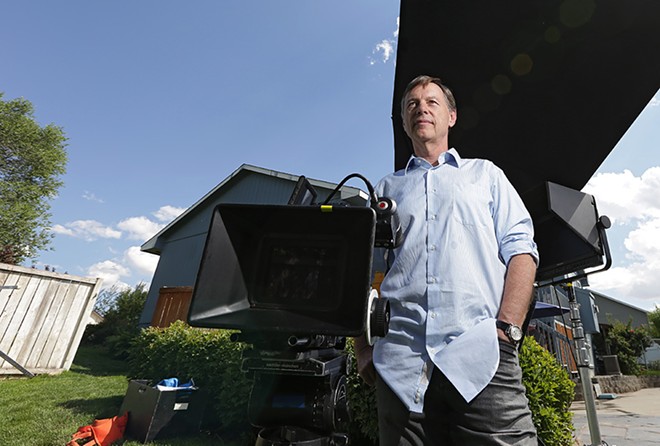
The call for a horde of zombie extras that went out two weeks ago was the culmination of a journey North by Northwest began in 2012.
“Over two years ago, we said this was going to be the new direction for the company. Television,” says Rich Cowan, NxNW’s founder. It was a somewhat dark time to be dreaming big. Washington state had lost its film tax incentive amid legislative wrangling in May 2011, and much of the feature film work NxNW was accustomed to began to dry up. When the incentive was reinstated in April of the next year, the definition of “film” was expanded to include anything meant to be viewed on a screen, including television and, conceivably, web-based series. Cowan says they leapt at that revision.
And though the casting call heard ’round the region somewhat short-circuited their victory lap, tomorrow at a 10 am press conference, North by Northwest will officially announce a partnership with SyFy and the Asylum — the production company behind Sharknado — to bring Spokane its first scripted TV series, Z Nation.
We’re in the midst of what many critics are calling a golden age of television, so scripted dramas are creatively appealing. Cowan, though, says the decision to pursue the small screen was more pragmatic. “It was always about the jobs,” he says. “Feature [films] are good, but you never know when the next feature is coming, so when are we going to take the kids to Disneyland?”
Z Nation’s budget is rumored to be around $500,000 per episode. Cowan says Syfy is specifically not releasing the per-episode budget, but he says the money will finance over 12,000 worker days for the production crew, almost a half-year’s worth of work. Cowan characterizes these as “good, solid, family-wage jobs.” (It should be noted that Cowan is currently running for state Senate, challenging Michael Baumgartner.)
Just as encouraging for our creative scene, the jobs don’t stop with grips and best boys. Cowan says they pitched North by Northwest — and Washington state — as a studio and region fully capable of supplying all production needs, including actors and directors, and Syfy bought it. The showrunner, Karl Schaefer, is a Hollywood veteran who has done offbeat, enjoyable work like Eureka and Eerie, Indiana, but much of the cast will be local-ish.
When I first chatted with him in March, Cowan said he hoped to cast at least half of the series’ eight featured actors (the starring roles, effectively) from within Washington state. Casting was still ongoing as of press time, but when we spoke yesterday, Cowan told me, “We’re tracking about half the leads from in-state. That’s an awesome thing. The showrunner and the network are loving our in-state people.”
Syfy has ordered an entire 13-episode season, which means somewhere in the neighborhood of 200 day players — roles that last an episode or two — will join the featured actors. “We have a lot of wonderful actors here, so we’ll be able to pull a lot of actors from here, and they’ll almost all be from within the state of Washington,” Cowan says. “I’m thankful we have that kind of talent pool. You can’t do that in every city, but we can.”
He also hopes to get one or two local directors episode credits in Season 1, but nothing is set in stone yet.
It’s important to note that Z Nation will not be The Walking Dead, either in terms of tone or budget. Schaefer has been quoted as saying his show will offer “a sense of hope to the horror of the apocalypse.” And while a half million bucks is a nice number, it’s well off the industry average. In figures cited by the New York Times in 2010 and Slate again earlier this month, the average cable drama costs $2 million per episode, about four times Z Nation’s budget. A blockbuster episode can cost many times more than that. Game of Thrones’ now legendary “Blackwater” cost around $8 million.
Still, Cowan believes Z Nation is an important first step in getting more work in serial drama. At the most basic level, if Season 1 goes well, there’s always Season 2 to look forward to. It’s about building a reputation for success, and then expanding upon it. “We have good actors here and good directors and a great crew,” Cowan says. “More series are the goal, and it’s a step at a time, but we’ll get there.”
Z Nation and its 1,300 zombie extras will begin groaning its way around the area in May. ♦
Luke Baumgarten, a creative strategist at Seven2 and former culture editor of the Inlander, is a co-founder of Terrain and the founder of Fellow Coworking. He tweets @lukebaumgarten.
Tags: Z Nation , NxNW , Comment , Culture , commentators , Arts & Culture , Image
Thursday, April 17, 2014
Coldwater Creek is going bankrupt. For most people around the country, that’s not a big deal. Coldwater Creek is just a women’s clothing store, which has failed to keep up with the times and consequently seen its sales dwindle — especially with the recession.
But to Sandpoint, Coldwater Creek is foundational to the area’s economy and culture. With over 500 jobs at their corporate headquarters, which often pay well above the county average, the financial impact is hard to miss. It will be a painful hit for a community that is still reeling from the housing crash.
Coldwater Creek is also a major philanthropic force in the community. They are key supporters of the arts, education and economic development — even when it wasn’t directly connected to their interests.
Several years ago, Coldwater Creek’s founder proposed building a U of I campus in Sandpoint. Right after the proposal was announced, Coldwater Creek’s stock cratered, and the plan was put off. The demise of Coldwater Creek also likely puts an end to that dream.
Perhaps most significantly, though, is the impact that Coldwater Creek employees have had on the community, independent of their day jobs. A lot of creative people have been able to afford to live and live well in Sandpoint and the surrounding area because of their jobs with Coldwater Creek. These people are also artists, musicians and patrons of the arts (sometimes all three). Sandpoint’s arts community will suffer from the loss of supporters and even more so as some of the people who make it what it is are forced to move to find good jobs.
All of this adds up to one big sad mess, but it’s worth remembering that there was never any reason why Coldwater Creek had to exist and few companies last forever. I wish the ride had lasted (decades) longer, but I am grateful for the impact it — and the people who work there — have had on the community I love. ♦
John T. Reuter, a former Sandpoint City Councilman, is the executive director of Conservation Voters for Idaho. He has been active in protecting Idaho's environment, expanding LGBT rights and the Idaho Republican Party.
Tags: Coldwater Creek , Comment , commentators , Image
Friday, April 11, 2014
My dad, Dennis Baumgarten, is the most fastidiously moral person I have ever met or known. He is so deeply Good — capital G — I often feel that I’ll never match his kindness, compassion or selflessness. The way he treats people is a model for the way I try to treat people. I always come up short, but his is a signpost I guide myself by.
At the same time, my dad is very wary of “People” — anyone in the reckless, 24-hour news cycle of anonymous chaos that defines modern life — who might do harm to my mother or my brother or me. He is a veteran, an avid hunter, a passionate advocate for gun rights, and a lifetime NRA Member (a membership he purchased, he remembers precisely, in 1977 for $106).
My dad grew up in a violent part of a bad town in central California. He came to the woods of North Idaho and, eventually, Eastern Washington to be closer to nature, certainly, but also, I think, to have more control over his physical environment and the people in it.
The two most salient things I remember from my childhood living up a long country road northeast of Chattaroy are these: my parents always kept the door to our home open to anyone who needed our help, and they always kept a pistol close at hand in case someone wanted to do us harm.
When Gail Gerlach was found not guilty on charges of manslaughter in the death of Brendon Kaluza-Graham yesterday, I felt such an intense and nauseating swirl of emotions, it was as if the world had lost its mooring.
So today, I did what I do whenever I feel my moral foundation and my understanding of the world shaken. I called my dad.
Have you been following the Gerlach case?
I have a little, but I also know people who know him and from what I understand, the man [Gerlach] is extremely frustrated with the amount of crime around his home and they’ve always had problems and problems and he’s just had it. He was frustrated.
The police are a reactionary force. They don’t prevent crime, so I understand that frustration, but would I shoot somebody who is stealing my truck? I wouldn’t go to that extreme, myself.
So when would you consider using your gun?
The only time I would ever use it is if our life was threatened. If there’s no other way out.
How do you make that decision?
It would be a really hard call to make. You never have ideal circumstances. But if somebody’s stealing my truck, psh. I’m not going to use a gun. I’ve never seen a U-Haul behind a hearse. You can’t take that with you. The guy stealing [Kaluza-Graham] was in the wrong in every possible way, but that’s still too far.
Gerlach says he believes [Kaluza-Graham] pointed a gun at him as he was driving away. He said he feared for his life.
Well, if someone fired a gun at me I’d return fire. I’d protect myself.
But [Kaluza-Graham] didn’t fire. He didn’t have a gun.
[Gerlach] may have seen something, or thought he saw something, but that’s a horrible thing to live with. If I felt my life was in danger, I’d return fire. I’d empty the clip.
But the first thing you taught me — the first thing I learned in gun safety — is to check your backstop. Would you unload a clip into a car driving away when your neighbor’s houses are the backstop?
If there’s people around and someone’s shooting at me, I wouldn’t miss. But I would avoid [shooting] all costs because if there were kids anywhere around, [and one of them got hit] that would just be awful.
And then once you kill the guy, that truck is just out of control!
You’re right. A truck is like a missile.
You wouldn’t just get back into the house until the guy was down the block or around the corner? If he’s driving away and you think he might be pointing a gun over his shoulder?
If I thought it was going to endanger someone else, I would duck! If he’s shooting at me and there’s a bunch of people behind him, I’m just gonna hug the dirt as hard as I can. If I get hit, I get hit. And if I die, I die. I can’t really endanger somebody else — innocent people — like that.
So here’s the question I’ve been really fighting with. All of this is assuming there are a bunch of people walking around, carrying guns, trying to kill people. Is it good — is it a good idea — to always be this hyper-vigilant against violence?
That’s the big question of the day.
Are we too scared of each other in this country?
Well, I feel like there’s a lot of — with gangs and stuff — the news spreads this mentality that the world is unsafe and maybe the world is getting more dangerous or difficult. I don’t really see it myself, here. But if someone comes in my shop, I’d avoid everything, but if they want to shoot at me, I’m going to have to live with the choice to do this.
Violent crime isn’t getting worse, though. It’s going down.
I did read that! I did, but I hear about these shootings in places — the gangs and the Colorado shooting and [Newtown]. I don’t know why anyone would do those things, but there are innocent people getting shot right and left and it worries me.
But it’s not newsworthy to not shoot someone. It’s not newsworthy to show restraint, so of course all we hear about is violence.
You’re right about that. You also never hear about the good people who carry [guns]. There are a lot of good people who carry.
You carry. And you’re the best person I know.
[Laughs] I don’t know about that. But if you have a home invasion, what are you going to do? Yeah, take my stuff, but what if they want more than stuff? Nine times out of 10 you don’t need a gun —
Do you really think you need a gun 10 percent of the time?
No, no. Say 99 times out of a hundred you don’t need a gun. But that one time, I want to be able to defend myself. I’m getting to an age where I probably couldn’t win a fight, and I’ve got to protect your mom and our family. You’ve got to be prepared.
I get that, and if someone is standing in your living room he’s moving toward mom, defending her and yourself makes total sense. But the guy Gerlach shot didn’t have a gun, and Trayvon Martin didn’t have a gun, and [Chad Oulson] in the movie theater didn’t have a gun. I feel like people are getting so worried about that 1 time in 100 that they’re afraid of every person they see. I feel like this vigilance against the perception of violence is driving everyone crazy.
I think that’s true to a huge degree. We don’t have any compassion or love for our neighbor. And that doesn’t just have to be your next door neighbor. Your neighbor is anyone around you. It’s the guy stealing stuff, even.
You need to be concerned about your neighbor. You need to care for them. You love them. People who get on dope, you don’t stop loving those people. It’s your job to do what you can to help them. And if they don’t want help, you let them go. You say, “alright, buddy.” But you have your arms open if they come back.
As a Christian you’ve got to put other people before yourself, and you try to figure out how to do that as best as possible. But it’s very, very hard to know. ♦
Tags: Comment , commentators , Image
In an alternate universe, Brendon Kaluza-Graham is working at a meaningful job and has enjoyed access to all of the services he may need to succeed. He has options outside of crime to pursue a living, and a supportive community helping when he slips up. Gail Gerlach never shot him, because he didn't have a reason to steal his SUV. Opportunities for people to redeem themselves for past mistakes abound in this other place, but not in the here and now. In our universe, just yesterday, a jury of 12 Spokane residents confirmed a cultural story about dangerous criminals, people less than you or I, who deserve punishment, even punishment outside of the law, for their actions.
Yesterday, the jury determined Gail Gerlach was not guilty of manslaughter. Just over a year ago, Gerlach shot dead Kaluza-Graham as he drove away in Gerlach's SUV, stolen from the driveway as it warmed up for its morning commute. Directly after the shooting, a heated debate sprouted around the issues of self defense, gun rights and vigilante justice. I was disturbed then by the amount of fervent support for Gerlach's right to shoot dead a person who threatened only his property.
Is the SUV an extension of the self? When driving, a vehicle acts as an extension of the driver's body and their safety becomes tied up together. An SUV in the driveway, though? Occupied by only the would-be thief? According to many barstool pundits in the weeks following, and now seconded by a jury in Spokane County, killing a person as they steal property is legitimate self defense.
I have had three bikes stolen in as many years. While the value of a basic commuter bike and the value of Gerlach's SUV look very different on paper, they serve a proportionate function in each of our lives. I depend, as he does, on my vehicle to get me to and from work and play. I transport the necessities of life from their source to my home on its back, and he does the same with a little more elbow room. We both put time and money into maintenance of our vehicles and take pains to keep them safely locked. Two of my bikes have been stolen right under my nose, off of the porch of my house. I can understand the rage that Gerlach must have felt when he caught the perpetrator red-handed. If I had seen the people who took my bikes in the act, it's very likely that I would have lost my temper, chased them down. It is wrong to take things from people without their permission, and those actions have consequences.
I have a temper, and I might have socked that bike thief pretty hard had I caught him. But I also have a sense of perspective and a sense that my bike is important to me, but not irreplaceable. In our culture of incredible materialism coupled with disconnection from one another's humanity, incidents like this shooting are one of many likely consequences. As the media and the criminal justice system further dehumanize criminal offenders, the general public becomes less aware of their humanity. People who steal cars have, in all likelihood, already made a series of mistakes in their lives. Statistically, they have been victims themselves. Abuse, neglect, mental illness, addiction and a free-fall through the many deep cracks in our safety nets are the common traits that those in our jails and prisons share. None of these factors makes a person less human than an object, even an object we depend upon in our daily life.
Rather than being about gun rights or gun control, this case has sent a message about who is valuable and who is disposable in the eyes of the average people who comprise a jury. The front page story about the acquittal in today's Spokesman-Review pulls out a quote from Gerlach to top the headline. He said, “As Christians, we believe in redemption. The greatest tragedy is that Mr. Brendon Kaluza-Graham will not have a chance to turn his life around.” As a non-Christian, I believe in redemption too, both for Kaluza-Graham and for Gerlach. Unfortunately, our justice system's focus on punishment and isolation over treatment and our culture's devaluation of people who have made mistakes join forces to create an atmosphere in which the odds are not in redemption's favor.
I can only hope that the work being done in Spokane around moving toward Smart Justice, which matches offenders with services that can help mitigate their unmet needs, continues to move forward and provide a real chance at redemption for people who make mistakes. I expect that in the courtroom, the jurors felt a great deal of empathy for both the slain Kaluza-Graham and the defendant. Let's see if we can move our society to one where expressing our empathy happens sooner and the expression is deeper. Then the alternate universe described above can become part of our reality. ♦
Taylor Weech, who hosts the weekly public affairs program Praxis on KYRS-FM, is a Spokane writer and activist. She's advocated, among other things, for environmental sustainability and all-ages access to the arts.
Tags: Comment , commentators , Image
Tuesday, April 8, 2014
Three strangers bought coffee for the person behind them in line today. Two people burst spontaneously into song and at least one opted to wait for his drink outside, “in the suh-un!” Every spring, the delightful and varied Spokanites shed their bleak winter cloaks and get wild. In our northern climate, the winters take a very real toll in the form of seasonal depression. Washington residents have, unsurprisingly, a rate of Seasonal Affective Disorder (SAD) seven times that of Florida. But fear not, SAD’s less clinical cousin has arrived this week. Commonly known as spring fever and bearing symptoms from heightened energy to enhanced sex drive, the phenomenon has been observed for centuries by poets and, more recently, by scientists. Despite content that is notoriously dark, Emily Dickinson wrote, “A little madness in the spring/ Is wholesome even for the King.”
Starting with the first big surge of the falls and lasting through the early backyard garden harvests, spring in this region more than makes up for the long and often emotionally challenging winter. The old is rotting while the new bursts forth from every place it can. Get out there and enjoy it however you like over the coming weeks; here are a few great places to start.
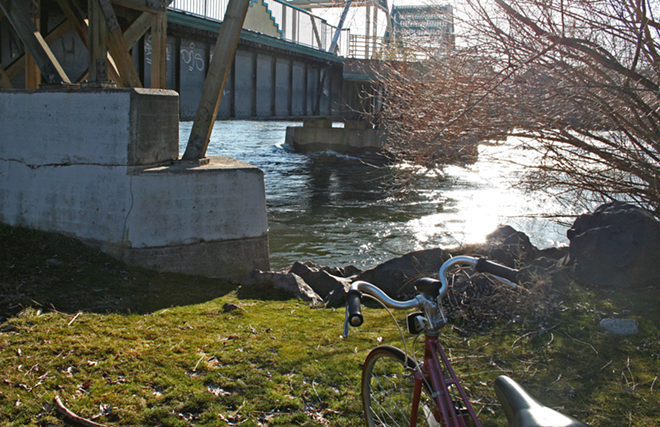
Tags: Comment , For Fun! , commentators , Image
Tuesday, April 1, 2014
Women’s History Month has drawn to a close, but with women comprising 51 percent of the U.S. population, perhaps we can continue to tell our stories for more than one month of 12. History is really just a collection of stories about people. Culture as a whole is about the stories we tell our children; these stories help build the framework of how they understand their place in society and the world. Unfortunately, when our films, television and other media tell stories, they tend to be stories about men in which women play a supporting role.
This observation is backed up by a mountain of numbers supporting it. While women make up the majority of the population, only 16 percent of protagonists in film are female. Is this because women are uninteresting or unrelatable? One answer emerges if we examine who is creating these stories. Filmmaking brings together writers, cinematographers, editors and directors who work together to bring a story to life. In these four key positions, again only 16 percent of the total are women. In ownership and board membership of major media companies, women are also unrepresented dramatically. Men aren’t unable to tell women’s stories, but this imbalance perpetuates the existing disparity by normalizing the absence of deep, fully human female characters.
If we look to history and literature, though, there is no shortage of fascinating women to learn from and enjoy. When I was recently asked to identify a woman who influenced me as a feminist, the best ones I could think of were Dorothy and Alice. Exploring Oz and Wonderland, respectively, they provided excellent examples of the type of tough, thoughtful, rebellious, crafty and kind woman I might want to become. When I looked at my favorite books and movies and historical figures now, I found fewer stories as centered on women as those from my childhood. So, I asked Facebook to help out and my friends generated a great list of ass-kicking, nurturing, scheming, leading and learning women.
They shared mythical goddesses like Kali, Hindu goddess of empowerment, time and death; and Athena, the Greeks’ go-to goddess for knowledge, strategy and crafts; and memorable characters like Pandora, Clytemnestra, and Dierdre. Scheherazade, the original captivating female storyteller appeared alongside former “most dangerous woman in America” Mother Jones, and her fellow rabble rousers Ella Baker, Emma Goldman and Gloria Steinem. Women and girls solved mysteries in Nancy Drew, modern mystery series, and even in the Magic Schoolbus kids’ series. Ellen Ripley, Sarah Connor, Katniss Everdeen and Captain Janeway were represented in the science fiction category, a genre historically dominated by men.
While a younger woman I talked with “couldn’t think of a single one (influential female story)” and “was raised on Disney and princesses,” this group of people came up with an extensive list of fiction written by women and populated by strong female characters. Alice Walker, Maya Angelou, Margaret Atwood, Toni Morrison, Frances Hodgson Burnett, Amy Tan, Ana Castillo, Audre Lorde, Tina Fey, bell hooks, Virginia Woolf, Amy Goodman, and more were recommended as required reading for all people, regardless of gender. Earlier this month, Rachel Dolezal shared her to-do list for Women’s History Month. My only addition is a suggestion for readers to find a story from this list, or ask someone you like for their favorite woman’s story, and listen. Just listen. ♦
Taylor Weech, who hosts the weekly public affairs program Praxis on KYRS-FM, is a Spokane writer and activist. She's advocated, among other things, for environmental sustainability and all-ages access to the arts.
Tags: Women's History Month , Comment , Culture , commentators , Arts & Culture , Image

